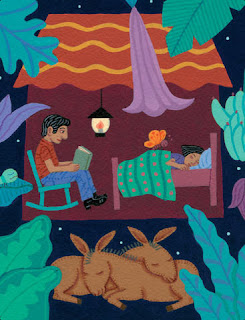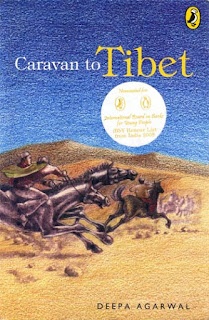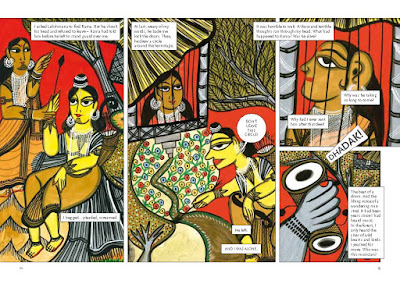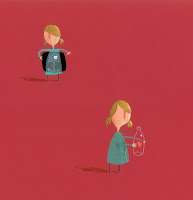What’s common to a
picture book located in Colombia, an Eoin Colfer book and a book of poems? Lucid,
easy-flowing narration, outstanding artwork and the sheer joy of reading? Of
course – and what else? Do read on …
The first of the
three books is a non-fiction picture book based on the extraordinary deeds of a
Colombian philanthropist bibliophile; the second is a work of fiction, a
chapter book that uses irreverent humour to introduce children to the library
and vice-versa; the third is a book of carefully selected poems for children
that unpack the idea of a library as a place of unexpected delights. The books
are a visual treat too with the work of remarkable illustrators like Jeanette
Winter, Tony Ross and Jill Manning.
Biblioburro: A true story from Colombia. Jeanette Winter. Beach Lane,
2010. 28 pages. Picture Book.
This is a charming tale of a man called Luis Soriano who sets up
a travelling library on the backs of two donkeys (burros). Luis, a
schoolteacher, loves reading and buying books, except that soon enough, his
house runs out of space. He decides to travel with his books to remote hamlets
in Colombia, where he gathers the children to tell them stories and encourages
them to borrow books from his Biblioburro. The books cast a spell over
everyone, be it child or bandit. (Does that intrigue you? Get a copy of the
book and read to know more!)


While the text is simple and flowing, I could not take my eyes
off the artwork. It spills right across the page into glorious doublespreads,
and uses the most vivid colours to capture the beauty of the Amazon rain forest
with its diverse plant and animal life. The butterflies that flit across every
page are characters in themselves. The illustrator’s name is not mentioned
clearly, but the fine print says the illustrations are copyrighted by Jeanette
Winter. Winter is well-known for her attractively illustrated and narrated
picture books, many of which tell true tales of uncommon heroism.
This is a book that I would love to gift to children both for
the inspiring narrative and the eye-catching illustrations.
The Legend of Spud Murphy. Eoin
Colfer. Illustrated by Tony Ross. Puffin, 2004. 90 pages. Chapter Book.
Having associated Eoin Colfer
with the Artemis Fowler series, I was rather surprised to come across this book. It’s a funny book about libraries and librarians and
having taken baby steps into the world of library evangelism, I decided that I
must read this. This book is part of a series involving the many adventures of
Will Woodman, and has won the Charlotte Award (2006) and the Flicker Tale
Children’s Book Award (2006).
Ms Murphy, the librarian is called
Spud by the kids who fear her believing she shoots at library defaulters with a
spud gun. One summer, Bill, the nine-year-old narrator is marched off to the
public library three times a week for two hours at a time along with his
ten-year-old brother Marty as their mother finds bringing up five children to
be an exhausting task. Like most parents all over the world, Will’s parents see
the library primarily as an educative place.
At the library, Will and
Marty are issued pink cards and restricted to the children’s section where they
sulk, pretending to read. However, one day, something catches Bill’s eye: “It
was the first sentence of the story … I decided to read a bit more. I wouldn’t
read the whole book, no way. But maybe just another couple of sentences.” It’s
a magical moment and soon enough, Bill and Marty begin to love reading and have
“the time of their lives”. The humour too never ceases with their several
run-ins with the legendary Spud Murphy.
I loved the way the writer
transforms the library from its perceived fearful avatar to a place that holds excitement
and adventure, without sounding preachy. The illustrations by Tony Ross enhance
the quirky appeal of the book. Ross appears to be a fan of the more famous
Quentin Blake, on whose work he models his own art.
Jumping
off library shelves. Edited by Lee Bennett Hopkins. Illustrated by
Jane Manning. Wordsong, 2015. 32 pages. Book of poems.
This delightful anthology
brings two of my childhood favourites together – poems and tomes. A book of
poems that celebrate the library, not as a staid old building filled with
books, or a ‘temple of learning’ but as a world of experiences that could be as
varied as getting your first library card which is “More powerful than/ the
smartest phone/ more powerful than/ a TV remote, more powerful than/ a hundred apps” (Cynthia Cotton); the pleasure of snuggling
up with a book as “Page by page/ line by line/ word by word/ I make
books mine” (Jane Yolen); talking with the empathetic librarian – “you/ read/ my/
heart” (Joan
Bransfield Graham); or just sitting beside a bookshelf when “Morning pours spoons of sun/ through tall windows” and you “live in story” (Rebecca Kai Dotlich).
These
short poems can be read aloud and enjoyed by children who are naturally drawn
to verse. They applaud every aspect of the library, and especially the
librarian who dons various hats as a storyteller, a book-finder and a
door-opener to magical worlds where “books become pillows/ stories come
calling” (Amy Ludwig Vanderwater). Of
special interest is Hopkins’ poem dedicated to a great librarian Augusta Baker.
It’s titled “The Storyteller” and Hopkins writes, “As she speaks/ words/ leap
from pages --/ … I walk/ down a/ yellow brick road./ Worlds of paper/ disappear
--/ only/ Miss Augusta/ and I/ are here/ in a room/ filled with magic/ story/
rhyme. I believe in/ happily ever after”.
Jill Manning’s charming gouache and pencil
illustrations further enhance the magic created by the words and picture the
library as both a warm and enticing refuge and an exciting place to be in. I
would certainly recommend this book to children for it captures in the simplest
of verse the magic of reading that I experienced as a child. One particular
poem by Nikki Grimes stood out for me and I wished I had written it myself:
My
library comes into view
Almost there!
I sprint
the last few yards,
charge
up the stone steps, breathless,
and push
through the double doors,
smiling
at the sweet kingdom of story
inviting
me in
to rest,
to explore –
to
dream.
While
all the three books romanticize the library to an extent, Colfer and Winter
also touch upon the transformative power of reading. I think these books will
help young readers to see the library with new eyes and put their tech toys
away and surrender to the lure of “pages where genius weaves/ letters into
magic” (Dotlich).




























